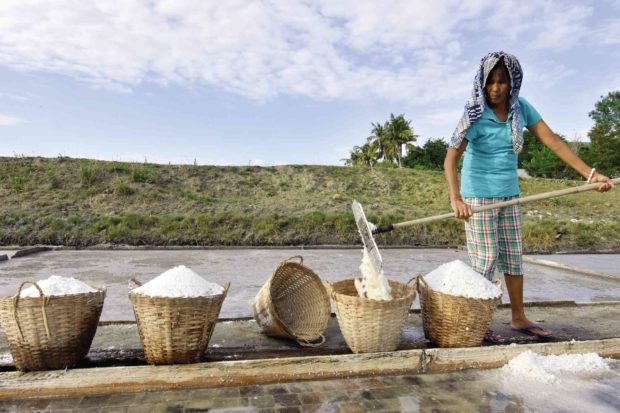Keeping salt farms alive
DASOL, Pangasinan — Using a wooden rake, Martino Colorado, 74, skillfully propels white crystals that have formed on the ceramic-tiled floor of the salt bed to the edge of a shallow pond.
Colorado’s grandson, Jessie Dumacas, 29, collects the small mounds of white crystals in a bamboo basket, then deposits the salt harvest in a small warehouse.
This is routine work in salt farms in Barangay Hermosa here every salt-making season in the last 80 years.
Salt-making has been a major source of livelihood in 11 of Dasol’s 18 villages, said Gwendolyn Bustamante, the town’s tourism officer.
In 2016, Dasol produced about 18,000 metric tons of salt from its more than 10,000 “banigan” (salt beds), according to the town’s agriculture office.
Article continues after this advertisementTribute to salt farmers
Article continues after this advertisementWhen the town celebrated its fiesta this month, it integrated the Asin (Salt) Festival as a tribute to its salt farmers.
Dasol would soon offer tourists an actual salt farm experience, Bustamante said, by taking them to a salt farm and allowing them to harvest salt on a “pick and pay” scheme.
“I was told by doctor friends that harvesting salt has therapeutic effects,” Bustamante said, adding that the planned salt farm tourism program would provide farmers with an additional source of livelihood.
Salt farm workers start harvesting salt at 4 p.m. and leave the salt beds at 6 p.m., after they have filled the empty salt beds with the right amount of sea water for the sun’s heat to turn into salt.
Benefits of heat
February brings cloudy skies, so each of the 85 salt beds tended by Colorado yields only a basket of salt. “This is what we usually get from December to February,” he said.
The yield doubles from March to mid May when the sun is at its hottest.
A farm worker is entitled to one of every three baskets of salt produced which he or she packs into 60-kilogram sacks and sells for P220 a sack.
“It’s not much but these salt farms fed my family,” Colorado said. After a salt-making season, he has money to buy food and other needs of his family.
Once the rains set in in the last week of May, the salt beds are filled with water, converting them into “bangus” (milkfish) ponds.
“In some ponds, we raise shrimps,” said Manuel Bonilla, 64, who works in another salt farm.
They would wait for three months for the bangus to be harvested before they could get one third of the produce as their share.
